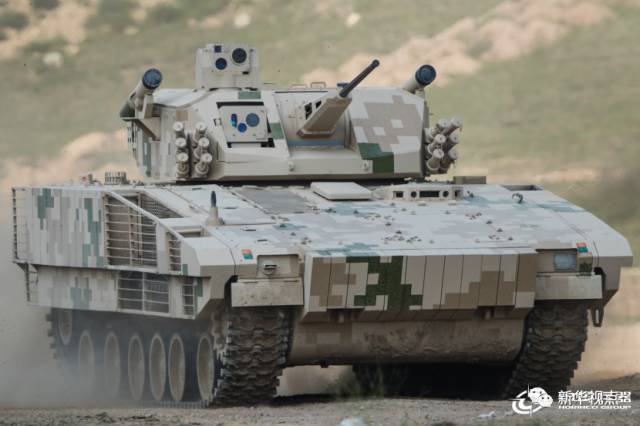More details on our next-gen IFV:
"VN-17 30 ton class IFV based on VT-5 tank's chassis, unmanned turret, 30mm gun, 2 HJ-12 anti-tank missiles."
Don't know what the specs are for this IFV, but it doesn't seem like it will be amphibious. I wonder if they are going with a different philosophy on this vehicle.
First define amphibious, If you mean can it be floated in a certain straight between the mainland and a Certain island between the South China sea, East China sea, Philippines sea. then no.
If however you want to cross a shallow body of water like a lake ( not Lake Titicaca or the Great lakes.) or shallow river then fine.
If we look at this vehicle what we see is a proper medium IFV. now note the sprocket on the front of the chassis now there are some tanks with Sprockets on the front but if we compare to the VT5 which this Chassis is supposed to be from... VT5 has it's Sprocket in the rear.

What this means is the Chassis is on backwards. Not a bad Idea.
now Why do that? There have been other vehicles that took lighter often older Tank Chassis and converted them into IFV and APC's in the past The Israeli T55 based Achzarit or the WW2 Kangaroo APC's for example. The biggest issue is that almost every tank is mid engined with the power pack of the tank in the rear and the Armored Glasius in the front. that is perfectly fine for a tank which is armor to the front against the enemy
the problem is when you start trying to add infantry to the vehicle the aim of the vehicle changes. for a Tank light medium, heavy or Main Battle the key mission is to bring that gun to the enemy. to keep that gun in the fight and the crew is there to keep that gun in the fight. It's the Child of Cavalry and Artillery.
For and APC or IFV the most important key mission of the vehicle is Infantry. It is a shield for Infantry it is a mobile pillbox for infantry. So where the Tank needs to get the gun to the fight and keep it in the fight the APC needs to protect the Infantry and the IFV needs to protect, transport and support the Infantry.
To do that you want to shield the infantry. now there have been some attempt at using the turret space for infantry space and the like but
you sheild the infantry with the vehicle. If you want to shield the Infantry you place infantry compartment in the rear of the vehicle. So if you look at purpose built IFV's and APC's they have the engine to the front either to a side like the bradley or just filling the front space like the Merkava Namer. In this case I think the Chinese are closer to the latter.
Because of this they have to make changes to the Transmission to basically reverse the system so the enge pours more power to the "new front" They also need to change the armor around the engine compartment to make room for the driver hole and added protection. with this done they can now use what was the armored prow of the tank to build the crew compartment.
Now this track has a 30 ton weight a 3+7 crew and a auto cannon so It's an IFV
because of it's Common chassis with the light Tank it would probably do well in the highlands and Deserts of the Gobi. however it's an Export number VT17. In terms of Firepower a Close match the the VT12 but I think this would be a higher end export model.In terms of weapons it's about par for the course a 30mm cannon likely a 7.62 coax and 2 ATGM. so a bit more Duka then the Bradley's 25mm but less then the CV90's 35 and new 40mm coming on new French and British AFV's
it has a heavier weight and a 1000 hp engine and probably more room to evolve. Compared to other offerings on the market. That power pack is a killer. as it gives a HP advantage compared to the Bradley A3, Kurganets-25, K-21 NIFV, CV90, even the German Puma, but not the Lynx And it's not a HIFV like the Namer or T15 so it will have a better power to weight Armor potential is pretty good for a 30 ton probably can go up by 10 tons with add on protection not HIFV class but better than the standard PLA IFV or most in it's class. especially if they add a APS.
In terms of Specs I think this could compare with the German Lynx.












